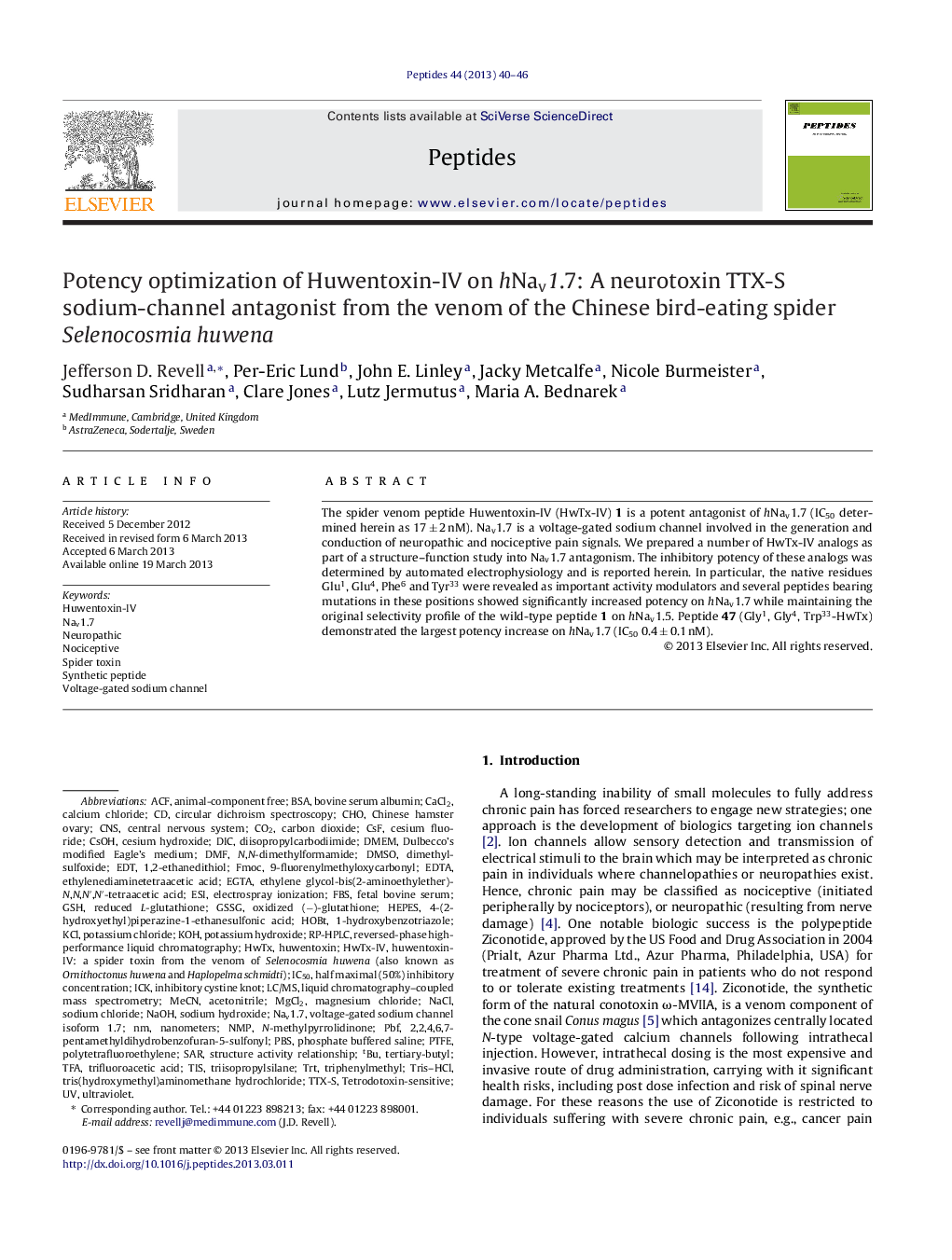| Article ID | Journal | Published Year | Pages | File Type |
|---|---|---|---|---|
| 8348703 | Peptides | 2013 | 7 Pages |
Abstract
The spider venom peptide Huwentoxin-IV (HwTx-IV) 1 is a potent antagonist of hNav1.7 (IC50 determined herein as 17 ± 2 nM). Nav1.7 is a voltage-gated sodium channel involved in the generation and conduction of neuropathic and nociceptive pain signals. We prepared a number of HwTx-IV analogs as part of a structure-function study into Nav1.7 antagonism. The inhibitory potency of these analogs was determined by automated electrophysiology and is reported herein. In particular, the native residues Glu1, Glu4, Phe6 and Tyr33 were revealed as important activity modulators and several peptides bearing mutations in these positions showed significantly increased potency on hNav1.7 while maintaining the original selectivity profile of the wild-type peptide 1 on hNav1.5. Peptide 47 (Gly1, Gly4, Trp33-HwTx) demonstrated the largest potency increase on hNav1.7 (IC50 0.4 ± 0.1 nM).
Keywords
GSSGNaCl2,2,4,6,7-pentamethyldihydrobenzofuran-5-sulfonylDICMgCl2TISdiisopropylcarbodiimideACFIC50TriisopropylsilaneEGTAGSH9-FluorenylmethyloxycarbonylMECNTFARP-HPLCICKNMPHOBttBuPBFNav1.7TTX-SKOHFMOCPTFEDMFPBSSARtriphenylmethylDMEMFBSN-methylpyrrolidinoneESIInhibitory cystine knotTRTReduced l-glutathioneNaOHHEPESEDTKClCaCl21-hydroxybenzotriazole1,2-Ethanedithiol4-(2-Hydroxyethyl)piperazine-1-ethanesulfonic acidBSADMSOLC/MSDulbecco's modified Eagle's mediumN,N-dimethylformamidebovine serum albuminEDTAethylene glycol-bis(2-aminoethylether)-N,N,N′,N′-tetraacetic acidEthylenediaminetetraacetic acidAcetonitrileTrifluoroacetic acidUltravioletChoTetrodotoxin-sensitiveChinese Hamster OvaryTris(hydroxymethyl)aminomethane hydrochlorideTris–HClCNSCarbon dioxideDimethylsulfoxideStructure activity relationshipCesium fluorideSodium chloridefetal bovine serumSpider toxincentral nervous systemCircular dichroism spectroscopyPhosphate buffered salineCSFNociceptiveNanometersNeuropathichalf maximal (50%) inhibitory concentrationsodium hydroxideCesium hydroxidePotassium HydroxidepolytetrafluoroethyleneSynthetic peptidevoltage-gated sodium channelCO2reversed-phase high-performance liquid chromatographyMagnesium chloridePotassium chlorideCalcium chlorideelectrospray ionization
Related Topics
Life Sciences
Biochemistry, Genetics and Molecular Biology
Biochemistry
Authors
Jefferson D. Revell, Per-Eric Lund, John E. Linley, Jacky Metcalfe, Nicole Burmeister, Sudharsan Sridharan, Clare Jones, Lutz Jermutus, Maria A. Bednarek,
